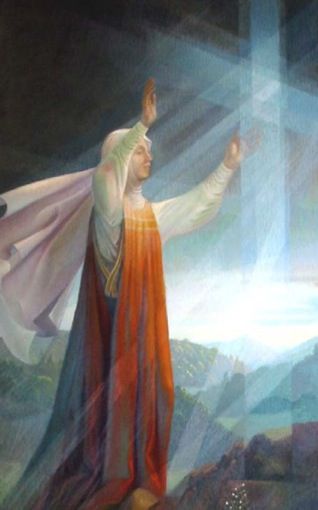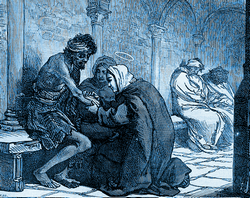 St. Angela of Foligno's "second phase" in her spiritual, mystical journey to union with God, includes more spiritual experiences and consolations but of the type she could describe with thoughts and words. (This is in contrast to the state of union in which one cannot really describe the experience, one is so absorbed in God; He takes full precedence to the soul's yearning love.)
St. Angela of Foligno's "second phase" in her spiritual, mystical journey to union with God, includes more spiritual experiences and consolations but of the type she could describe with thoughts and words. (This is in contrast to the state of union in which one cannot really describe the experience, one is so absorbed in God; He takes full precedence to the soul's yearning love.)An important emphasis is this: Angela's (and usually no one's) spiritual ascent to God is in concrete phases, as such. One does not tick like clockwork, advancing steadily through the purgative, illuminative, and unitive ways; it is more like an upward spiraling effect.
Back and forth goes the soul while in perpetual motion, spiraling upward but going back and forth between growth and consolations, and growth and desolations. [Years ago the Lord gave vision of a double helix, intertwining while spiraling, to explain the process of the soul's journey to God; picture a double helix, if that helps.]
Fra. Arnaldo, Angela's confessor continued to write down the "steps" of Angela's spiritual ascent, as best he could from what she described to him after-the-fact. Her next phase involved the fulfillment of the promise made to her previously, that the Holy Trinity would dwell in her soul. It occurred during a pilgrimage she made to Assisi. Her intentions were to ask St. Francis to help her "feel Christ" within her, to live the Rule of Third Order of St. Francis well, and that she truly end up "poor".
At a crossroads near Assisi, she had a tremendous inner experience of the Holy Spirit. In a major awareness of the Holy Spirit, Angela was promised a "consolation that she has never tasted before." She then experienced an awakening in her inner senses--a moment in which she "saw the created universe resplendent with God's presence and herself as if one with it." (LaChance, p. 13) Continuing on to Assisi, she felt Christ's presence with her and into the Basilica of St. Francis.
 There, while kneeling in front of a stained glass window depicting Francis set within Christ, she heard Christ tell her:
There, while kneeling in front of a stained glass window depicting Francis set within Christ, she heard Christ tell her:"Thus I will hold you closely; and much more so than can be imagined with the eyes of the body. For now is the hour, my temple, my delight, when I will fulfill what I told you; for as to this consolation, it will depart from you; but I will never depart from you; but I will never depart from you, if you love me." (LaChance, ibid.)
As Angela later recounted this to Fra. Arnaldo, she said she realized the Holy Trinity had come into her and was dwelling within. The Holy Spirit came first; next Christ was crucified for her; then she sensed the Triune God (Father, Son, Holy Spirit). They assembled together, but simply. It was a simple yet profound indwelling.
Angela had crossed over a major threshold with this vision. It is called the betrothal, God's pledge of final union. God told her: "You have the ring of my love. You are bound to me and henceforth you will never leave me. May the blessing of the Father, the Son, and of the Holy Spirit, be with you." (LaChance, ibid.)
After this experience, Angela had quite a visceral reaction. She shouted and rolled on the ground outside the basilica, and cried out, "Unknown Love! Why? Why? Why?" Angela was overcome with longing for the Beloved who seemed to have left her after having come so intensely close.
[This represents the betrothal but not yet the marriage of union. Even with the marriage, Christ may seem to leave or even says He will leave but will come back later to consummate the marriage. The yearning soul seems to languish from having been so close, yet now must wait without knowing how long. It seems an agony in itself counterposed with the indescribable delight of the betrothal and/or marriage.]
Angela returned to Foligno but was enrapt in all that had transpired within. The next "steps" within this phase increased Angela's awareness and depth of Christ's Passion and greater understanding of the Cross. She had evolved in her spiritual growth to no longer be an onlooker of Christ's life and Passion but was as if with Him in His Passion.
Her visions included seeing Christ's crucified body shining through His sufferings. She felt Christ crucified, reaching His arm around her in support; she entered into the wound in His side. Angela gained an understanding within of how Christ suffered more in His soul than in His body, and how His divinity suffering in His humanity was like a cloak for His Divinity. She then was shown and understood more deeply each of His sufferings on the Cross.
 Angela then had a three-day vision in which she was experienced the Virgin Mary and Christ in their glorified bodies. Then, on Holy Saturday, 1294, she entered into a communion with the events taking place within Jesus during the Holy Triduum. In the Holy Spirit, she was with Christ in the sepulchre:
Angela then had a three-day vision in which she was experienced the Virgin Mary and Christ in their glorified bodies. Then, on Holy Saturday, 1294, she entered into a communion with the events taking place within Jesus during the Holy Triduum. In the Holy Spirit, she was with Christ in the sepulchre:"eyes closed lying there dead.... A most wonderful and indescribable odor emanated from His mouth as she kissed it.... She then placed her cheek against Christ's own and He in turn placed His hand against her other cheek and pressed her closely to Him." (LaChance, p. 15)
Despite these experiences of identifying with Christ's suffering allowed her to love far more deeply, this phase also had periods of doubt, despair, temptation, persecution. [In the spiritual journey, there is the intertwining of the heights and the depths, the delights and the despairs. Also, these "steps" in phases do not necessarily occur exclusively as if once at this level, there is no return to other levels or phases.]
"The game of love" it is called--when it seems as if the Bridegroom distances Himself or "hides" from His Beloved--the soul He desires and who so desires Him. He seems to be intimately present, with spiritual upswings and gifts, and then He seems to disappear, without indication of when or if He will return. Angela experienced this game of love with Christ, and she learned through the suffering which caused growth, that she was not suffering for herself, but for love of the suffering Christ.
 The more she grasped the reality of suffering, the more she realized He was within her; she understood the necessary aspect of suffering as requisite in conjunction with love. She then had an experience in which Christ was able to transform the reality of suffering into joy.
The more she grasped the reality of suffering, the more she realized He was within her; she understood the necessary aspect of suffering as requisite in conjunction with love. She then had an experience in which Christ was able to transform the reality of suffering into joy."She and her companion had gone 'to meet Christ' among the lepers in the hospital in Foligno. After drinking of the water she had used to wash the sores of one of the lepers, she reported that it was 'so sweet that it was as if I had received Communion.' This is a thoroughly Franscican example: Christ and the leper mutually inform one another as icons of divine disclosure." (LaChance, p. 16)
During these steps, Angela also had visions of the Eucharist--a powerful mystical experience for her and most mystics. Once the Host was resplendent as the sun; another time it was as if two eyes gazed at her; in another, Christ as a child was seated on an adorned throne. After receiving Communion on another occasion, God spoke to her:
"'I want to show you something of My power. And immediately the eyes of the soul were opening and in a vision I beheld the fullness of God's presence encompassing the whole of creation, that is, what is on this side and what is beyond the sea, the abyss, the sea itself and everything else. And in everything that I saw, I could perceive nothing but the presence of God, and in a manner totally indescribable. And my soul in excess of wonder cried out, 'This world is pregnant with the presence of God (pregnans di Deo)!'" (LaChance, ibid.)
Angela grasped and experienced the close relationship between Christ's Passion and the Eucharist. Both exemplify "divine self-giving, power manifesting itself in weakness (kenosis), and elevating the soul to a higher level of intimacy with Christ"--which comprise Angela's core spirituality. (LaChance, ibid.)
As her mystical experiences grew in attributes of His divine perfections, they were not as graphically describable. Rather, she had grown to a higher level that combined personal and transcendent, sublime yet inexpressible. She had come to recognize God's great and intimate love of her; and she also recognized that God was the love of her soul: "...there is nothing in Him but love, and He requires nothing more of the soul than it loves Him in return." (LaChance, p. 17)
Angela "spoke of having attained, on the one hand, a true knowledge of self--of her poverty and nothingness--and, on the other hand, a true knowledge of the overwhelming kindness of God." (LaChance, ibid.) Despite such knowledge, Angela still had a dark night of soul to transverse.
[I will continue this overview of Angela of Foligno's mystical journey, covering her third and final phase in which union occurs--that which transforms the soul beyond thoughts and words.]
No comments:
Post a Comment